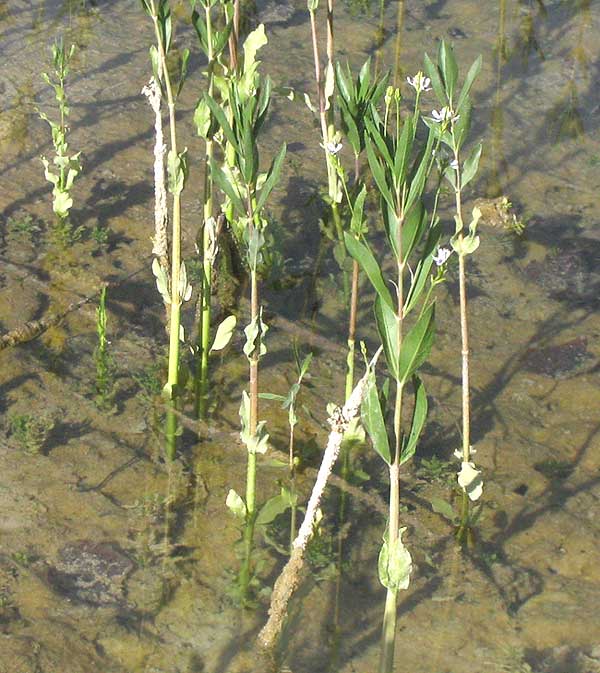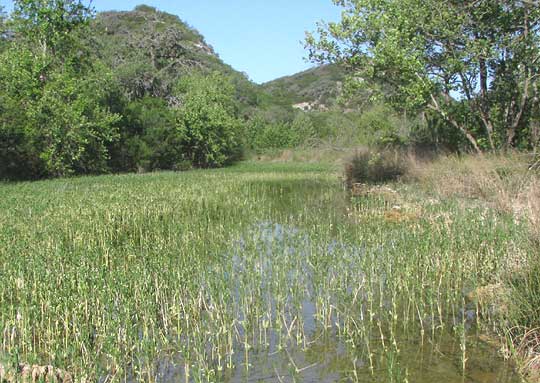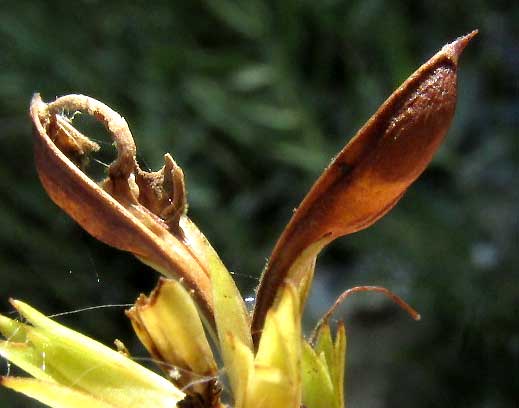Excerpts from Jim Conrad's
Naturalist Newsletter

from the May 26, 2013 Newsletter issued from the Frio Canyon Nature Education Center in northern Uvalde County, southwestern Texas, on the southern border of the Edwards Plateau; elevation ~1750m (~5750 ft); N29.62°, W99.86°; USA
WATER-WILLOW FLOWERING
The US Drought Monitor Page at http://droughtmonitor.unl.edu continues to say that here we are experiencing a D4-level "exceptional" drought, which they define as more extreme than the D3 "extreme" one. The little Dry Frio River behind the cabin has become a chain of isolated pools separated by gravel ridges. Still, here and there pools are large and frog-inhabited enough that visiting them you can almost forget the drought. Below you can see a pretty picture showing one such pool:

Trees along the banks are mostly American Sycamores. However, here we're interested in the knee-high, leafy, herbaceous switches emerging from the water from bank to bank bearing willow-like leaves and white flowers, as shown at the top of this page.
Mud on some of the plants' stems indicates how fast the water level has been dropping. The ¾-inch broad (2cm) flowers are worth bending over to look at, for they're almost like miniature orchid flowers, as shown below:

This herbaceous, aquatic perennial is one known by everyone in the eastern US and adjacent Canada who visits wetlands and pays attention: It's the American Water-willow, JUSTICIA AMERICANA, a member of the Acanthus Family, the Acanthaceae.
In Mexico we experienced the Acanthus Family as a big, commonly encountered one, but here in the Temperate Zone not many species in the family can survive our winter temperatures. So that's something special about water-willows: They're the most cold-tolerant members of their mostly tropical Acanthus Family. In southern Canada, where the American Water-willow is the only native representative of the Acanthus Family, it's so rare that it's officially regarded as threatened, and a program is in place to reintroduce the species.
Good field marks for the Acanthus Family, nicely displayed by our water-willows, include the fact that the flowers are bilaterally symmetrical -- they're "zygomorphic" like most mint and orchid flowers -- not radially. In other words, there's only one plane across which you can cut the blossom resulting in mirror images on both sides of the plane. Also, flowers bear either two or four stamens, not the more typical five or multiples thereof. Leaflike bracts beneath the individual flowers, and fruits shaped a bit like upside-down violins confirm the family.
In our flower picture you can see that our water-willow blossom has two stamens, each consisting of a white, slender filament curved at the top where it bears two dark brown, pollen-producing anthers facing away from one another. In our photo the nearest anther cell has been eaten off. The slender, white style emerges between the two stamens and rises above them. The style it tipped with a tiny, Y-shaped, white stigma. The style is the "neck" between the ovary at the flower's bottom, and the stigma at the top. Water-willow flowers are mostly bee pollinated.
In Uvalde County we have a second member of the genus Justicia, the purple-flowered Hairy Tubetongue, Justicia pilosella, which we met in the April 7th Newsletter. You might enjoy comparing the Water-willow's flower with that of the tubetongue's at http://www.backyardnature.net/n/h/tubetong.htm.
from the August 17, 2014 Newsletter issued from the Frio Canyon Nature Education Center in the valley of the Dry Frio River in northern Uvalde County, southwestern Texas, on the southern border of the Edwards Plateau; elevation ~1750m (~5750 ft); N29.62°, W99.86°; USA
WATER-WILLOW'S EXPLOSIVE, UPSIDE-DOWN VIOLINS
At this location we've profiled several members of the Acanthus Family, the Acanthaceae: the Mexican Honeysuckle; Wild Petunia; Torrey's Wrightwort; Water-willow, and; Hairy Tubetongue. Normally in our discussions of these species it was said that an important field mark for the Acanthus Family is that its mature fruits typically are shaped like plump, upside-down violins, with their slender necks issuing from a cuplike calyx.
Around here the most commonly occurring member of the family is the Water-willow. Earlier we documented them when they were flowering. Nowadays, later in the season, with the vast majority of plants emerging from a bone-dry bed, a few plants bear fruits, but mostly they bear neither fruits nor flowers. You can see a Water-willow's split-open fruit below:

To appreciate the fruit's upside-down-violin form you must visualize the fruit before it split, so that the V-shaped split fruit becomes a slender neck arising from the green calyx, with the neck greatly bulging at the top. You can see a similar fruit, before it split open -- and one with a bug-eaten hole in it -- of the Torrey's Wrightwort at http://www.backyardnature.net/n/13/130915ad.jpg.
Why is our Water-willow's fruit split so strangely? It's because when the fruit, a capsule, is mature and conditions are right, the fruit snaps open explosively, sending seeds flying for several feet. The capsule's upside-down violin shape, then, is understandable because the farther away a seed can be from the calyx, the more momentum it can have when the capsule splits, and the farther away it can be flung. In our Water-willow fruit, one seed remains because its interior has been devoured.
In general appearance, the Torrey's Wrightwort and Water-willow plants are very unlike one another, yet you can see that their upside-down violin fruits are very similar. Some plant families, such as the big Rose Family, produce fruits in a huge variety of forms, but the Acanthus Family seems to love its explosive, upside-down violins.